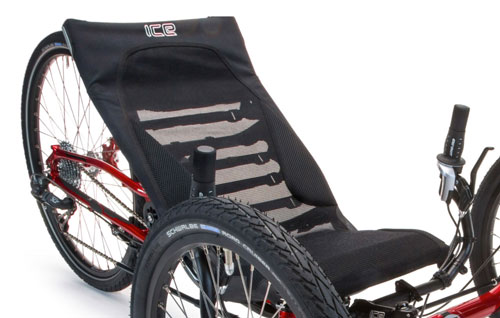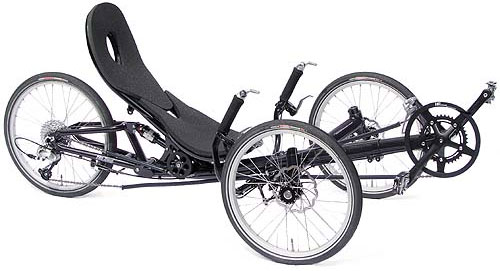What is a Recumbent Trike?
The basis of a trike in this context is three wheel pedal cycle more generally ridden by young children. Many young disable children use trikes to help develop body function and strength but many find the standard trike to be very unstable. The modern recumbent trike is not primarily designed for people with a disability but for very energetic people who like pushbike type transport with a difference and some comfort. Aero dynamics and a recumbent position go hand in hand.
More and more now, trikes are being designed so that modifications or accessories can be introduced to allow people with less agility to enjoy the benefits of recumbent cycling. For some, the addition of the third wheel can mean the difference between cycling and not cycling.

The recumbent trikes benefits arise from the rider being placed in a laid-back reclining position with the added advantage of high stability from a low centralised centre of gravity. This reclined posture enables the rider’s feet to be placed comfortably in line with their body allowing the legs to provide maximum power generated against the seat back and not dependant on lifting the handlebar type efforts.
On a recumbent trike, the rider reclines into a comfortable seat which provides plenty of support for the back and buttocks. The rider’s weight is spread over a large area as opposed to a normal upright bike which focuses the body weight on an often small seat with a lesser amount of your weight on the feet and hands.

Tadpole Trikes
Recumbent Trikes Benefits (comfort and stability) – stem largely from Tadpole trikes which refers to the trike having the two wheels up front as opposed to a standard trike with two wheels at the rear and a single wheel at the front (delta trikes). The tadpole style gives much greater stability in cornering and heading down hill especially on unstable ground (gravel etc). Tadpole trikes are generally shorter than their counterparts (Delta Trikes) as they require longer overall length to maintain some stability.
Tadpole vs Delta Trikes
What are the main differences having two wheels at the front (tadpole) or back (delta).
On a delta trike with two wheels at the back and generally a differential, better traction for getting up a dirt or loose surface hill. Generally smaller wheels on a delta compared to a 26″ wheel on the average tadpole lessen the advantage. With a 26″ wheel there are a large variety of tyres available to assist with “off-raod” grip.
On a tadpole trike, two wheels at the front mean better stability, steering and braking going down hill with a loose surface than the delta. On a bicycle, going into a corner with a little gravel on it can mean a lot of lost skin and paintwork. On a tadpole you may have a better chance of doing a 180/360 but still end being on the seat.
Luggage: Many delta trikes claim to be able to carry 15-20kg of luggage but suffer in steering lightness as the load is carried behind the rider and behind the rear wheels. Most tadpole trikes will carry 30-40kg of luggage with the weight over the rear wheel and where space permits, some tadpoles allow more carry space under the seat and in front of the rear wheel. On a tadpole trike, the riders weight is generally distributed well amongst the three wheels. An advantage of a well loaded trike compared to a well loaded bicycle is you can stop and get off the trike and it doesn’t generally fall over.
Recumbent Trike Benefits
A recumbent trike provides many benefits to the rider. Recumbent trike benefits include:
- support for the back, buttocks and neck. This is especially essential for people with back and neck problems.
- comfort – the reclining seat supports the body which means less stress in the back, neck and shoulders. Also, the hands and wrists are not supporting the body as they are on an upright bike.
- body weight is spread over a larger, more comfortable seat which means no more ‘saddle soreness’ as often experienced on an upright bike.
- improved aerodynamics. Recumbent riders have a lower frontal area which reduces air resistance. This means riders expend less energy having to overcoming air resistance than traditional upright bike riders.
- less balancing required. With three wheels on the ground, the rider feels securely supported. This makes trikes the perfect vehicle for everyone, including people with disabilities.
- low speed stability. Unlike an upright bike, trikes maintain their stability at slow speeds.
- resting support. Riders are able to relax and come to a complete stop with ease, not having to worry about dropping their feet off the pedals as they have to on a two-wheeled upright bike. A recumbent trike provides a lounge chair in the outdoors! What more could you ask for!
- speed. A recumbent trike holds the world speed record for a cycle!
- low and light. Queensland Recumbent trikes are often low to the ground which means in the event of an accident, there’s a shorter distance to the ground … not that anyone really wants to do this in the first place!
- easy to ride. Recumbent trikes come with a wide range of gearing which enable riders to pedal smoothly over a variety of surfaces and inclines/descents.
- the high seat back provides more leverage when pedalling as the rider can push with his/her back against the seat.
- the feet-up-position is more efficient as it allows the body to circulate more oxygen-rich blood to the muscles.
- can be fitted with one or more power driven wheels.
- can tow a trailer for camping gear, a canoe and alike.
- you can ride to your fishing spot, pop up an umbrella and throw a line and all staying seated.
- ride to the footy or soccer with the kids and your seat arrives with you.
- with up to a 40 kilo capacity rack you can take home lots of shopping.
- adds the ability to safely carry medical aids.

If you have any questions about recumbent trike benefits, please contact us to find out how it can relate to you.